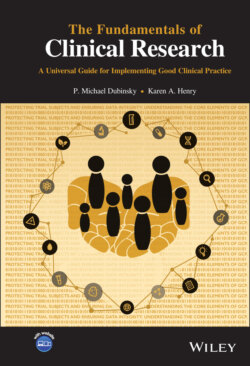Читать книгу The Fundamentals of Clinical Research - P. Michael Dubinsky - Страница 140
11.6 Inspections and Oversight
ОглавлениеMost regulatory authorities will be performing inspections as part of their clinical trial oversight role. Some regulators have a defined responsibility for conducting inspections of clinical trial related, i.e. GCP activities during the time period that the study is underway and some do not.
Clinical trial activities can be inspected at any time; however, such inspections are usually not conducted on a routine or programmatic basis but generally are driven by events. One such event is the successful completion of the overall clinical study which results in the submission of a marketing application. Another is to follow‐up on reports of noncompliance or complaints which are received either from the sponsor or some other source knowledgeable about the study. The nature and scope of such inspections are covered in Chapter 34 Regulatory Authority Inspections in some detail but suffice it to say that if inspections are scheduled and conducted, they will be rigorous and demanding.
Regulators, having the decision‐making responsibility for applications, want to ensure they make valid, supportable, and accountable decisions. Inspections are a mechanism of oversight that regulators use to aid in ensuring that clinical trial activities being conducted in their jurisdiction are performed in compliance with the investigational plan, the regulations, and GCP. Inspections can have a number of outcomes but it is important to keep in perspective that unlike audits conducted by a sponsor’s quality assurance staff, an inspection which documents significant noncompliance can result in legal/administrative penalties or sanctions being applied. The regulatory authorities have a responsibility to act on significant noncompliance in part to punish and in part to demonstrate that such behavior will not be tolerated.
Regulatory authority inspections of clinical trial activities are not mandated in all global regions or countries. For example, GCP inspections became a responsibility for EU member states when the EU Clinical Trial Directive 2001/20/EC became effective in 2004. In the United States, GCP inspections are authorized but not mandated by law or regulation. Whether mandated or not, inspections are a key role performed by regulators as part of their oversight activities. Inspections which are GCP in nature include inspections of trial sponsors, investigational sites, and institutional review boards. Inspections of the manufacturing of investigational articles may also be conducted but they would be categorized as GMP inspections. Inspections of animal and in‐vitro studies supporting CTAs are inspected but are categorized as Good Laboratory Practice (GLP) and are not addressed in this text.
With regard to investigator sites, regulators depend in large measure upon sponsors to serve as the primary go‐between with sites during the course of a study unless it becomes apparent that the sponsor is not exercising control over the site(s). If the application involves an investigator‐sponsor, then the situation is different; however, most of the discussion points above would apply since that person is also the sponsor. The one area of difference would be the matter of inspections. Regulators recognize that the investigator sites are where all of the key steps associated with the trial occur. Drug is administered, adverse reactions are recorded and reported, records are made and maintained, and subjects are given informed consent. Therefore, it is the inspections of sites where regulators spend the bulk of their available inspectional time when it comes to GCP compliance. Regulators will want to interact directly with the principal investigator at a site if they are aware of, or document noncompliances at the site. Clinical investigators are viewed as having a direct responsibility to ensure conformance with the protocol, the applicable regulations, and GCP at their site. Admittedly, they work through the sponsor on critical items such as reporting serious unexpected adverse reactions; however, the regulators usually have some administrative or legal mechanism available to bring to bear against noncompliant investigators. Administrative provisions granting regulators the ability to put clinical holds in place, disqualify clinical investigators, terminate sites, or limit enrollment are tools that regulators have available if serious noncompliance is documented during inspections.
